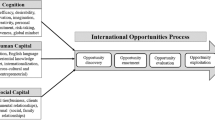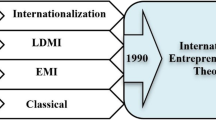Abstract
Despite burgeoning research in international entrepreneurship (IE), very little is known about the processes of how entrepreneurs recognize and pursue opportunities in international markets. To provide an answer to this “opportunity process gap,” we drew on the idea sets framework from the entrepreneurship literature to longitudinally examine a serial entrepreneur who achieved international market success with little industry-specific knowledge, networks, and resources. The research demonstrates the efficacy of the new approach as a lens and methodological framework to advance process-driven explanations and research in IE. These preliminary results reveal a new concept labeled here as opportunity portfolio processing, which involves discovery, creation, prototyping, pruning, and broadening of opportunity sets, that underpins the fundamental processes but not previously documented mechanisms in IE. Our study allowed us to induce a set of IE opportunity portfolio measures—volume, flow rate, novelty, magnitude, and geographical coverage—that offers an alternative framework for measuring and predicting IE performance. In developing the arguments, we present six findings including the role of prior history that, taken together, move us closer to an opportunity portfolio perspective in IE.





Similar content being viewed by others

References
Aldrich, H. E., & Cliff, J. E. 2003. The pervasive effects of family on entrepreneurship: Toward a family embeddedness perspective. Journal of Business Venturing, 18: 573–596.
Alvarez, S. A., & Barney, J. B. 2007. Discovery and creation: Alternative theories of entrepreneurial action. Strategic Entrepreneurship Journal, 1: 11–26.
Alvarez, S. A., & Barney, J. B. 2010. Entrepreneurship and epistemology: The philosophical underpinnings of the study of entrepreneurial opportunities. Academy of Management Annals, 4(1): 557–583.
Amabile, T. M. 1983. The social psychology of creativity. New York: Springer.
APEC Policy Support Unit. 2013. APEC SOM Steering Committee on Economic and Technical Cooperation. http://www.apec.org/Groups/SOM-Steering-Committee-on-Economic-and-Technical-Cooperation/Working-Groups/Small-and-Medium-Enterprises.aspx, accessed Aug. 16, 2014.
ASX. 2013. Plentex signed agreement to acquire Biovite. Australian Stock Exchange Announcement. http://www.asx.com.au/asxpdf/20131220/pdf/42lsbnj3p2c1h7.pdf, accessed Jan. 20, 2014.
Bergh, P., Thorgren, S., & Wincent, J. 2011. Entrepreneurs learning together: The importance of building trust for learning and exploiting business opportunities. International Entrepreneurial Management Journal, 7: 17–37.
Chandler, G. N., DeTienne, D. R., McKelvie, A., & Mumford, T. V. 2011. Causation and effectuation processes: A validation study. Journal of Business Venturing, 26(3): 375–390.
Chandra, Y., Styles, C., & Wilkinson, I. 2009. The recognition of first time international entrepreneurial opportunities: Evidence from firms in knowledge-based industries. International Marketing Review, 26(1): 30–61.
Chen, M.-J., & Miller, D. 2010. West meets East: Toward an ambicultural approach to Management. Academy of Management Perspective, 24(4): 17–24.
Cornellissen, J. P., & Clark, J. S. 2010. Imagining and rationalizing opportunities: Inductive reasoning and the creation and justification of new ventures. Academy of Management Review, 35(4): 539–557.
Coviello, N., & Munro, H. 1997. Network relationships and the internationalisation process. International Business Review, 6(4): 361–386.
Dimov, D. P. 2007. Beyond the single-person, single-insight attribution in understanding entrepreneurial opportunities. Entrepreneurship Theory and Practice, 20: 10–21.
Dorner, D. 1999. Approaching design thinking research. Design Studies, 20: 407–415.
Doz, Y. 2011. Qualitative research for international business. Journal of International Business Studies, 42: 582–590.
Dubois, A., & Gadde, L. E. 2002. Systematic combining: An abductive approach to case research. Journal of Business Research, 55(7): 553–560.
Dunning, J. H. 1980. Towards an eclectic theory of international production: Some empirical tests. Journal of International Business Studies, 11: 9–31.
Dunning, J. H. 1988. The eclectic paradigm of international production: A restatement and some possible extensions. Journal of International Business Studies, 19: 1–31.
Dunning, J. H. 1993. Multinational enterprise in the global economy. Wokingham, UK: Addison-Wesley.
Eisenhardt, K. 1989. Building theories from case research. Academy of Management Review, 14: 532–550.
Ellis, P. D. 2011. Social ties and international entrepreneurship: Opportunities and constraints affecting firm internationalization. Journal of International Business Studies, 42: 99–127.
Ellis, P., & Pecotich, A. 2001. Social factors influencing export initiation in small and medium enterprises. Journal of Marketing Research, 38(1): 119–130.
Elsbach, K. D., & Kramer, R. M. 2003. Assessing creativity in Hollywood pitch meetings: Evidence for a dual-process model of creativity judgment. Academy of Management Journal, 46(3): 283–301.
Felin, T., & Zenger, T. R. 2009. Entrepreneur as theorists: On the origins of collective beliefs and novel strategies. Strategic Entrepreneurship Journal, 3: 127–146.
Fisher, G. 2012. Effectuation, causation, and bricolage: A behavioral comparison of emerging theories in entrepreneurship research. Entrepreneurship Theory and Practice, 36(5): 1019–1051.
Gartner, W. B., Carter, N. M., & Hills, G. E. 2003. The language of opportunity. In C. Steyaert & D. Hjorth (Eds.). New movements in entrepreneurship: 103–124. London: Edward Elgar.
Gibbert, M., Ruigrok, W., & Wicki, B. 2008. What passes as a rigorous case study?. Strategic Management Journal, 29(13): 1465–1474.
Gioia, D. A., Corley, K. G., & Hamilton, A. L. 2012. Seeking qualitative rigor in inductive research: Notes on the Gioia methodology. Organizational Research Methods, 16(1): 15–31.
Harms, R., & Schiele, H. 2012. Antecedents and consequences of effectuation and causation in the international new venture creation process. Journal of International Entrepreneurship, 10: 95–116.
Hill, S. A., & Birkinshaw, J. M. 2010. Idea sets: Conceptualizing and measuring a new unit of analysis in entrepreneurship research. Organizational Research Methods, 13(1): 85–113.
Hohenthal, J., Johanson, J., & Johanson, M. 2003. Market discovery and the international expansion of the firm. International Business Review, 12: 659–672.
Isenberg, J. 1986. Thinking and managing: A verbal protocol analysis of managerial problem solving. Academy of Management Journal, 29(4): 775–788.
Johanson, J., & Mattsson, L.-G. 1988. Internationalisation in industrial systems—A network approach. In N. Hood & J. E. Vahlne (Eds.). Strategies in global competition: 287–314. New York: Croom Helm.
Johanson, J., & Vahlne, J. E. 1977. The internationalization process of the firm—A model of knowledge development and increasing foreign market commitment. Journal of International Business Studies, 8(1): 23–32.
Johanson, J., & Vahlne, J. E. 1990. The mechanism of internationalization. International Marketing Review, 7(4): 11–24.
Johanson, J., & Vahlne, J. 2006. Commitment and opportunity development in the internationalization process: A note on the Uppsala internationalization process model. Management International Review, 2(2): 165–178.
Jones, G., & Khanna, T. 2006. Bringing history (back) into international business. Journal of International Business Studies, 37(4): 453–468.
Jones, M. V., & Casulli, L. 2014. International entrepreneurship: Exploring the logic and utility of individual experience through comparative reasoning approaches. Entrepreneurship Theory and Practice, 38(1): 45–69.
Jones, M. V., & Coviello, N. E. 2005. Internationalization: Conceptualizing an entrepreneurial process of behaviour in time. Journal of International Business Studies, 36(3): 284–303.
Jones, M. V., Coviello, N., & Tang, Y. K. 2011. International entrepreneurship research (1989–2009): A domain ontology and thematic analysis. Journal of Business Venturing, 26: 632–659.
Karra, N., Phillips, N., & Tracey, P. 2008. Building the born global firm: Developing entrepreneurial capabilities for international new ventures. Long Range Planning, 41: 440–458.
Kelley, T. 2001. Prototyping is the shorthand of innovation. Design Management Journal, 12(3): 35–42.
Keupp, M. M., & Gassmann, O. 2009. The past and the future of international entrepreneurship: A review and suggestions for developing the field. Journal of Management, 35(3): 600–633.
Kontinen, T., & Ojala, A. 2011a. Network ties in the international opportunity recognition of family SMEs. International Business Review, 20: 440–453.
Kontinen, T., & Ojala, A. 2011b. International opportunity recognition among small and medium sized family firms. Journal of Small Business Management, 49(3): 490–514.
KPMG. 2013. KPMG family business. http://www.kpmgfamilybusiness.com/family-business-a-key-driver-of-asian-economies/, accessed Aug. 16, 2014.
Lee, S. H., & Williams, C. 2007. Dispersed entrepreneurship within multinational corporations: A community perspective. Journal of World Business, 42(4): 505–519.
Lee, T. W., Mitchell, T. R., & Sablynski, C. J. 1999. Qualitative research in organizational and vocational psychology. Journal of Vocational Behavior, 55: 161–187.
Mainela, T., & Puhakka, V. 2009. Organising new business in a turbulent context: Opportunity discovery and effectuation for IJV development in transition markets. Journal of International Entrepreneurship, 7: 111–134.
March, J. G. 1991. Exploration and exploitation in organizational learning. Organization Science, 2: 71–87.
March, J. G., & Simon, H. A. 1958. Organizations. New York: John Wiley & Sons.
McMullen, J. S., & Shepherd, D. A. 2006. Entrepreneurial action and the role of uncertainty in the theory of the entrepreneur. Academy of Management Review, 31(1): 132–152.
Mehl, M. R., & Pennebaker, J. W. 2003. The social dynamics of a cultural upheaval: Social interactions surrounding September 11, 2001. Psychological Science, 14(6): 579–585.
Muzychenko, O. 2008. Cross-cultural entrepreneurial competence in identifying international business opportunities. European Management Journal, 26(6): 366–377.
Nieto, M. J., & Fernandez, Z. 2006. The role of information technology in corporate strategy of small and medium enterprises. Journal of International Entrepreneurship, 3: 251–262.
Oviatt, B. M., & McDougall, P. P. 2005a. Defining international entrepreneurship and modelling the speed of internationalization. Entrepreneurship Theory and Practice, 29(5): 537–554.
Oviatt, B. M., & McDougall, P. P. 2005b. Toward a theory of international new ventures. Journal of International Business Studies, 3: 29–41.
Perry, J. T., Chandler, G. N., & Markova, G. 2011. Entrepreneurial effectuation: A review and suggestions for future research. Entrepreneurship Theory and Practice, 36(4): 837–861.
Pratt, M. G. 2009. For the lack of a boilerplate: Tips on writing up (and reviewing) qualitative research. Academy of Management Journal, 52(5): 856–862.
Reuters. 2013. Plentex Ltd to acquire Biovite Business. http://www.reuters.com/finance/stocks/PRM.AX/key-developments/article/2891348, accessed Jan. 20, 2014.
Sarasvathy, S. D. 2001. Causation and effectuation: Toward a theoretical shift from economic inevitability to entrepreneurial contingency. Academy of Management Review, 26(2): 243–263.
Sarasvathy, S. D., Kumar, K., York, J. G., & Bhagavtula, S. 2013. An effectual approach to international entrepreneurship: Overlaps, challenges, and provocative possibilities. Entrepreneurship Theory and Practice, 38(1): 71–93.
Sciascia, S., Mazzola, P., Astrachan, J. H., & Pieper, T. M. 2012. The role of family ownership in international entrepreneurship: Exploring nonlinear effects. Small Business Economics, 38: 15–31.
Shane, S. 2000. Prior knowledge and the discovery of entrepreneurial opportunities. Organization Science, 11: 448–469.
Shane, S. 2012. Reflections on the 2010 AMR decade award: Delivering on the promise of entrepreneurship as a field of research. Academy of Management Review, 37(1): 10–20.
Shane, S., & Venkataraman, S. 2000. The promise of entrepreneurship as a field of research. Academy of Management Review, 25: 217–226.
Sharma, P. 2008. Familiness: Capital stocks and flows between family and business. Entrepreneurship Theory and Practice, 32(6): 971–977.
Siggelkow, N. 2007. Persuasion with case studies. Academy of Management Journal, 50: 20–24.
Terjesen, S., Hessels, J., & Li, D. 2013. Comparative international entrepreneurship: A review and research agenda. Journal of Management, 20(10): 1–46.
Tuija, M., & Puhakka, V. 2009. Organising new business in a turbulent context: Opportunity discovery and effectuation for IJV development in transition markets. Journal of International Entrepreneurship, 7: 111–134.
Van de Ven, A. H., & Engleman, R. M. 2006. Event- and outcome-driven explanations of entrepreneurship. Journal of Business Venturing, 19: 343–358.
Van de Ven, A., & Poole, M. S. 1990. Methods for studying innovation development in the Minnesota Innovation Research Program. Organization Science, 1(3): 313–335.
Vaughn, D. 1992. Theory elaboration: The heuristics of case analysis. In C. Ragin & H. Becker (Eds.). What is a case?: 173–202. New York: Cambridge University Press.
Westhead, P. 2008. International opportunity exploitation behavior reported by “types” of firms relating to exporting experience. Journal of Small Business and Enterprise Development, 15(3): 431–456.
Wood, M. S., & McKinley, W. 2010. The production of entrepreneurial opportunity: A constructionist perspective. Strategic Entrepreneurship Journal, 4: 66–84.
Yin, R. K. 2003. Case study research: Design and methods, 3rd ed. Thousand Oaks: Sage.
Zahra, S. A., Korri, J. S., & Yu, J. 2005. Cognition and international entrepreneurship: Implications for research on international opportunity recognition and exploitation. International Business Review, 14(2): 129–146.
Acknowledgments
We are indebted to the APJM Editor Seung-Hyun Lee, two anonymous reviewers, Nicole Coviello, Tamer Cavusgil, Jim Bell, and colleagues at the Academy of Management Annual Meeting 2014 including Jean Boddewyn and George White for their invaluable comments and suggestions in the earlier versions this article. The article was partly financed by the UNSW Faculty Research Grant.
Author information
Authors and Affiliations
Corresponding author
Rights and permissions
About this article
Cite this article
Chandra, Y., Styles, C. & Wilkinson, I.F. Opportunity portfolio: Moving beyond single opportunity explanations in international entrepreneurship research. Asia Pac J Manag 32, 199–228 (2015). https://doi.org/10.1007/s10490-014-9400-1
Published:
Issue Date:
DOI: https://doi.org/10.1007/s10490-014-9400-1



